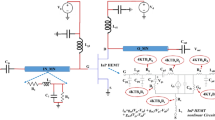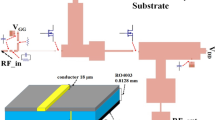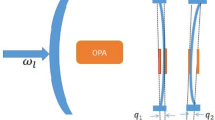Abstract
The microwave quantum correlation as a crucial issue in quantum technology is analyzed and studied. An open quantum system operating at 4.2 K is designed in which InP HEMT as the nonlinear component couples two external oscillators. The quantum theory is applied to analyze the system completely. The Lindblad Master equation is used to analyze the time evolution of the expanded closed system that covers the environmental effects. In the following, the state of the system defined is determined in terms of the ensemble average state using the density matrix; then, the ensemble average of the different operators is calculated. Accordingly, the covariance matrix of the quantum system is derived, and the quantum discord as a key quantity to determine the quantum correlation is calculated. As an interesting point, the results show that InP HEMT mixes two coupling oscillator modes so that the quantum correlation is created at different frequency productions, especially the zero-IF band. Nonetheless, the main point is that one can strongly manipulate the quantum correlation in the zero-IF using circuitry engineering. It is established by increasing the operational frequencies in the quantum system leading to dramatically limiting the thermal noise since the zero-IF band remains unchanged.






Similar content being viewed by others
Data availability
There are no datasets of this study that can be accessed.
References
Adesso, G., Datta, A.: Quantum versus classical correlations in Gaussian States. Phys. Rev. Lett. 105, 030501–030504 (2010)
Angelov I, Garcia M, Zirath H.: On the performance of different hemt cryogenic mixers. In: 1997 IEEE MTT-S international microwave symposium digest, Denver, CO, USA, vol.2, pp. 853-856, (1997)
Barzanjeh, S., Guha, S., Weedbrook, Ch., Vitali, D., Shapiro, J.H., Pirandola, S.: Microwave quantum illumination. Phys. Rev. Lett. 114, 080503–080508 (2015)
Barzanjeh, S., Pirandola, S., Vitali, D., Fink, J.M.: Microwave quantum illumination using a digital receiver. Sci. Adv. 6(19), eabb0451 (2020)
Blais, A., Huang, RSh., Wallraff, A., Girvin, S.M., Schoelkopf, R.J.: Cavity quantum electrodynamics for superconducting electrical circuits: an architecture for quantum computation. Phys. Rev. A 69, 062320 (2004)
Bourassa, J., Beaudoin, F., Gambetta, J.M., Blais, A.: Josephson-junction-embedded transmission-line resonators: from Kerr medium to in-line transmon. Phys. Rev. A 86, 013814 (2012)
Brodutch, A., Terno, D.R.: Quantum discord, local operations, and Maxwell’s demons. Phys. Rev. A 81, 062103–062106 (2010)
Cha, E., Wadefalk, N., Nilsson, P., Schleeh, J., Moschetti, G., Pourkabirian, A., Tuzi, S., Grahn, J.: 0.3–14 and 16–28 GHz wide-bandwidth cryogenic MMIC low-noise amplifiers. IEEE Trans. Microw. Theory Tech. 66, 4860–4869 (2018)
Cha, E., Wadefalk, N., Moschetti, G., Pourkabirian, A., Stenarson, J., Grahn, J.: InP HEMTs for Sub-mW cryogenic low-noise amplifiers. IEEE Electron Device Lett. 41, 1005–1008 (2020)
Dakić, B., Ole Lipp, Y., Ma, X., Ringbauer, M., Kropatschek, S., Barz, S., Paterek, T., Vedral, V., Zeilinger, A., Brukner, Č, Walther, P.: Quantum discord as resource for remote state preparation. Nature Phys. 8, 666–670 (2012)
Ferraro, A., Aolita, L., Cavalcanti, D., Cucchietti, F.M., Acín, A.: Almost all quantum states have nonclassical correlations. Phys. Rev. A 81, 052318–052326 (2010)
Giorda, P., Paris, M.G.A.: Gaussian quantum discord. Phys. Rev. Lett. 105, 020503–020504 (2010)
Houck, A.A., Schreier, J.A., Johnson, B.R., Chow, J.M., Koch, J., Gambetta, J.M., Schoelkopf, R.J.: Controlling the spontaneous emission of a superconducting transmon qubit. Phys. Rev. Lett. 101, 080502–080504 (2008)
Jeffrey, E., Sank, D., Mutus, J.Y., White, T.C., Kelly, J., Barends, R., Chen, Y., Chen, Z., Chiaro, B., Dunsworth, A.: Fast scalable state measurement with superconducting qubits. Phys. Rev. Lett. 112(19), 190504 (2014)
Johansson, J.R., Nation, P.D., Nori, F.: QuTiP 2: a python framework for the dynamics of open quantum systems. Comp. Phys. Comm. 184, 1234 (2013)
Khalid, U., Rehman, J., Shin, H.: Measurement-based quantum correlations for quantum information processing. Sci. Rep. 10, 2443 (2020)
Kleine U, Bieger J, Seifert H.: A low noise CMOS preamplifier operating at 4.2 kelvin. In: Proc. 19th Eur. Solid-State Circuits Conf. (ESSCIRC), vol. 1, pp. 134–137, (1993)
Merali, Z.: Quantum computing: the power of discord. Nature 474, 24–26 (2011)
Patra, B., Incandela, R.M., van Dijk, J.P.G., Homulle, H.A.R., Song, L.: Cryo-CMOS circuits and systems for quantum computing applications. IEEE J. Solid-State Circuits 53, 309–321 (2018)
Pirandola, S., Spedalieri, G., Braunstein, S.L., Cerf, N.J., Lloyd, S.: Optimality of gaussian discord. Phys. Rev. Lett. 113, 140405–140415 (2014)
Salmanogli, A.: Entanglement generation using transistor nonlinearity in low noise amplifier. Quantum Sci. Technol. 7, 045026–045035 (2022)
Salmanogli, A.: Squeezed States generation using cryogenic InP HEMT transistor nonlinearity. J. Semicond. 44, 1–9 (2023)
Salmanogli, A., Gokcen, D.: Entanglement sustainability improvement using optoelectronic converter in quantum radar (interferometric object-sensing). IEEE Sens. J. 21, 9054–9062 (2020)
Salmanogli, A., Gokcen, D.: Design of quantum sensor to duplicate European Robins navigational system. Sens. Actuators A Phys. 322, 112636 (2021)
Salmanogli, A., Gokcen, D., Gecim, H.S.: Entanglement sustainability in quantum radar. IEEE J. Sel. Top. Quantum Electron. 26, 1–11 (2020)
Salmanogli A.: Qubit coupling to reservoir modes: engineering the circuitry to enhance the coherence time, arXiv preprint arXiv:2205.13361, (2022)
Salmanogli A.: Quantum correlation of microwave two-mode squeezed state generated by nonlinearity of InP HEMT, arXiv preprint arXiv:2211.01620, (2022)
Scully, M.O., Zubairy, M.S.: Quantum optics. Cambridge University Press, UK (1997)
Schefer M, Lott U, Patrick W, Meier H, Bachtold W.: Passive, coplanar V-band HEMT mixer. In: Conference proceedings. 1997 international conference on indium phosphide and related materials, Cape Cod, MA, USA, pp. 177–180, (1997)
Wallraff, A., Schuster, D., Blais, A., et al.: Strong coupling of a single photon to a superconducting qubit using circuit quantum electrodynamics. Nature 431, 162–167 (2004)
Zwolak, M., Zurek, W.: Complementarity of quantum discord and classically accessible information. Sci. Rep. 3, 1729 (2013)
Funding
No funding.
Author information
Authors and Affiliations
Contributions
All the studies have been done by Ahmad Salmanogli.
Corresponding author
Ethics declarations
Conflict of interest
There are no competing interests for this study.
Ethical approval
This declaration is “not applicable”.
Additional information
Publisher's Note
Springer Nature remains neutral with regard to jurisdictional claims in published maps and institutional affiliations.
Appendix 1 The constants related to the Eq. (1) of the main article is defined as:
Appendix 1 The constants related to the Eq. (1) of the main article is defined as:
where gN2 = gm2 + 6gm3[∂φ1/∂t]DC, CM2 = CB(CA + CN)-Cc2, Z1 = √( L1/Cq1), Z2 = √( L2’/Cq2), CC = Cgd, CB = C2 + Cgd, CA = Cin + C1 + Cgs + Cgd, CA’ = CA + CN, CN = gm2[φ2]DC + 6gm3[φ2]DC*[∂φ1/∂t]DC, Īgs2 = Ig2-Ij2, Īds2 = ids2 + Id2 + Ij2. The thermally generated noises by the resistors and the current source are defined as Īg2 = 4KBT/Rg, Īd2 = 4KBT/Rd, Īj2 = 4KBT/Rj, ids2 = 4KBTγgm, and Īi2 = 4KBT/Ri, where KB, T, and γ respectively are the Boltzmann constant and operational temperature (Salmanogli 2023). C1 and C2 are the total capacitors generated due to the external oscillators coupling to the InP HEMT. The full information about the details of the circuit and the contributed constants can be found in Salmanogli (2023). For a clear and intuitive view about the quantities and their relations, a figure is directly taken from Salmanogli (2023), and presented in this section. Figure
Complete system model; LC1 coupling to LC2 through InP HEMT Transistor operating at 5 K (Salmanogli 2023)
7.
Rights and permissions
Springer Nature or its licensor (e.g. a society or other partner) holds exclusive rights to this article under a publishing agreement with the author(s) or other rightsholder(s); author self-archiving of the accepted manuscript version of this article is solely governed by the terms of such publishing agreement and applicable law.
About this article
Cite this article
Salmanogli, A. Enhancing quantum correlation at zero-IF band by confining the thermally excited photons: InP hemt circuitry effect. Opt Quant Electron 55, 745 (2023). https://doi.org/10.1007/s11082-023-04850-5
Received:
Accepted:
Published:
DOI: https://doi.org/10.1007/s11082-023-04850-5





